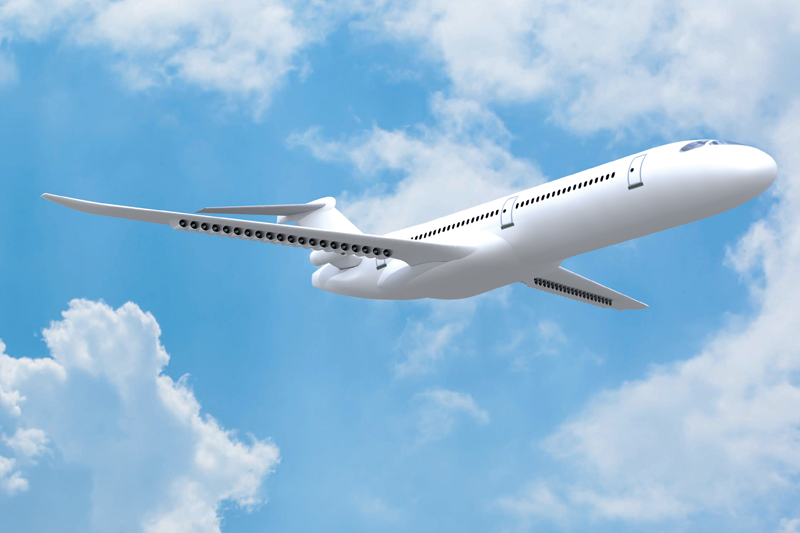How can we reduce fuel consumption? DRAGON
In response to increasing air traffic and to meet the standards imposed by Europe, aircraft manufacturers must innovate to reduce fuel consumption. ONERA, whose role is to push the envelope of knowledge in support of manufacturers, is studying one of the most promising lines of research: distributed electric propulsion.
An innovative concept
|
Discover the model at the ONERA booth in Bourget Hall 2A - booth C271 and meet its experts. |
DRAGON aims to evaluate the benefits and drawbacks of distributed electric propulsion for an airliner (150 passengers and a cruise speed of around Mach 0.8).
How? By distributing the thrust via a large number of electric ducted fans placed under each wing, which improves propulsion efficiency. These electric motors are powered by the electricity produced by turbines situated at the rear of the aircraft. This is hybrid propulsion technology since the on-board kerosene is transformed into electricity.
Compared to an airliner put into service in 2014, integration of distributed electric propulsion, together with expected changes in aircraft components by 2035, would reduce kerosene consumption by more than 25% for an 800 nm (1400 km) flight.
The fuel savings associated with electric propulsion alone range from 5 to 10%.
To better understand the physical phenomena involved, numerical modelling and simulations are carried out using various calculation codes developed by ONERA: the elsA software platform for aerodynamics, aerothermics and acoustics, the CAPRI computational chain for aeroelasticity and the MYSTIC program for evaluation of the complete aircraft.
Gains from this technology, estimated using digital tools, may be confirmed in the future through wind tunnel testing campaigns.
A team of multidisciplinary experts
 When evaluating a new technology such as distributed electric propulsion, it is important to take into account all possible interactions between the different disciplines and systems of the aircraft. The DRAGON configuration has therefore been developed through extensive dialogue and iterations between ONERA's research engineers, each bringing his or her own expertise. Overall, the multidisciplinary analyses concern 9 units operating under 5 departments: DAAA (Aerodynamics, aeroelasticity, acoustics), DEMR (Electromagnetism and radar), DMAS (Materials and Structures), DMPE (Multi-physics for energy) and DTIS (Information Processing and Systems).
When evaluating a new technology such as distributed electric propulsion, it is important to take into account all possible interactions between the different disciplines and systems of the aircraft. The DRAGON configuration has therefore been developed through extensive dialogue and iterations between ONERA's research engineers, each bringing his or her own expertise. Overall, the multidisciplinary analyses concern 9 units operating under 5 departments: DAAA (Aerodynamics, aeroelasticity, acoustics), DEMR (Electromagnetism and radar), DMAS (Materials and Structures), DMPE (Multi-physics for energy) and DTIS (Information Processing and Systems).
ONERA, a technology developer
In 2017, ONERA presented the AMPERE project : a regional distributed electric propulsion demo aircraft, capable of transporting 4 to 6 people over 500 km in 2 hours. Thanks to its blown wings, this aircraft could take-off over very short distances.
In line with this project, which has furnished a major experimental database, research into the DRAGON configuration has been funded by the European Commission since 2016 as part of the Clean Sky 2’s Large Passenger Aircraft Innovative Aircraft Demonstrator Platform coordinated by Airbus Commercial Aircraft.
The results will be used to best prepare the integration of this technology on a future aircraft for entry into service after 2035.